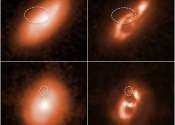Spitzer and Hubble telescopes find rare galaxy at dawn of time
(PhysOrg.com) -- Astronomers using NASA's Spitzer and Hubble space telescopes have discovered that one of the most distant galaxies known is churning out stars at a shockingly high rate. The blob-shaped galaxy, called GN-108036, ...








